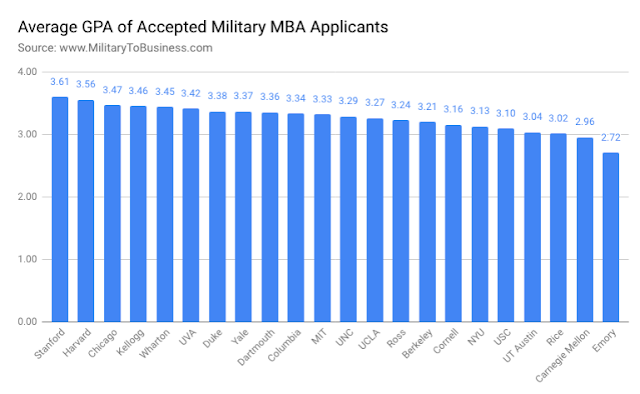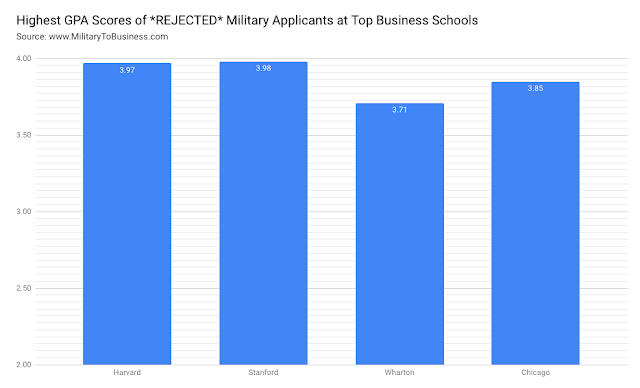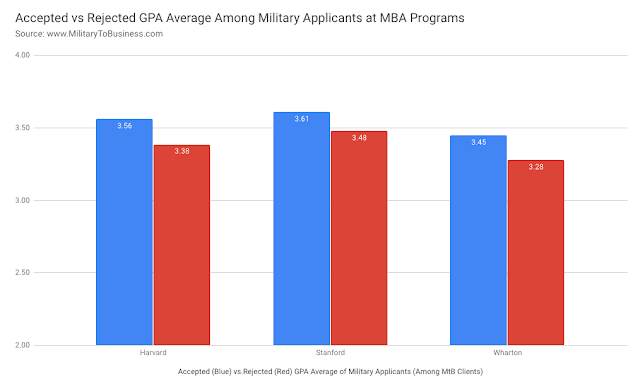How do military MBA applicants compare on GPA?
This is part two of our series analyzing data across hundreds of military clients applying to top business schools for their MBAs. In our previous post we reviewed GMAT scores, and in this post we will discuss GPA.
One big obvious difference is that there is nothing you can do to change your GPA, as opposed to the GMAT which you can retake and improve on. So if your GPA is considered low, there is no use in worrying about it because it's in the past and outside of your control, and there is no point in worrying about things you cannot change (what good does it do?). If your GPA is of concern for you, just double down your efforts on the rest of your application, including the GMAT if you have time.
That said, knowing where your GPA falls with top business schools is still an important factor because it can give you some partial insight into your competitiveness.
Not all identical GPAs are in fact equal. Here are some things to keep in mind while looking at this GPA data:
- A 3.5 in a technical field such as engineering or math is generally looked upon more favorably than a 3.5 GPA in a non-technical field.
- Similarly, a 3.2 GPA from an Ivy League would be looked upon more favorably than a 3.2 GPA from a low ranking school.
- Undergraduate trends make a difference, so if you GPA was 2.0 during your first two years and a 4.0 during the last two years, that is favorable to somebody who had a 3.0 throughout. This is an extreme example but conveys the point.
The following is the average GPA of accepted military applicants at top MBA programs:
Takeaways:
- The difference between each school and the next is fairly small, but overall they do add up and broadly follow competitiveness of each respective school.
- Similar to GMAT numbers, the school with the highest standard was Stanford and the second highest was Harvard.
- It seems there is a bit of a military "break" on the GPA front. Stanford reports an average GPA of 3.73, compared to an admitted military average of 3.61 (96.7% of average). Similarly, Harvard reports an average GPA of 3.71, compared to an admitted military average of 3.56 (96.0%) of average. Wharton only provides a round number of 3.6 average, whereas military members come in at 3.45 (95.8%). So the trend is for military members to be around 4% below the class average in GPA. One can say this is not a particularly significant different, but it is consistent. Some may argue that it's because some Ivy Leagues may have grade inflation and the service academies less so, but further scrutiny on this would be required.
What about a minimum GPA?
It's of course difficult to say what a minimum GPA is because it depends on many factors, including the rest of one's application. An applicant with a 780 GMAT will have a lower acceptable GPA than a student with a 680 GMAT. So if you're on the lower end of both GMAT and GPA, that is not a good sign and you should double down on your GMAT.
The following are minimum GPAs we have seen accepted at top schools. This is not an ehaustive list, it is only based on several hundred MtB clients:
Takeways:
- It is possible to get into a top program with a GPA in the low 3's, and even to some top 10 programs in the high 2's. For those that we have seen in the high 2's, they generally correspond to a GMAT that is above the school's average (so 740+). It would make sense that if one has a well below average GPA then at the very least they should bring forward an above average GMAT. Keep in mind average GPA and GMAT also affects a school's rankings.
- Top 20 schools such as Cornell, NYT, and UT Austin also give hope for students with mid 2's GPA, though for those students as well, plan on an above school average GMAT and definitely don't take an admission for granted by any means. Keep in mind these are the lowest scores we have seen accepted in a decade's worth of admission work.
Ok, so if I have a high GPA, how likely am I to get in?
GPA is only but one factor. Here are the highest GPAs we've ever seen rejected from a sample of top schools:
So having a 3.97 or a 3.98 is not an assurance you will get into Harvard or Stanford for example. Common reasons for being dinged is usually not a low GMAT score for those with such a high GPA, but rather poor decision making on how the applicant portrays themselves in the application, how they express their career goals, and potentially how they interview.
Ok, so how important is GPA for military applicants at top business school programs?
The average accepted applicant at Harvard, Stanford, and Wharton has a GPA of 0.18, 0.13, and 0.17 more than the average rejected applicant. This is not a huge difference but appears more significant than the mere 14 point gap on GMAT averages.
At Harvard for example, our average successful applicant has a GMAT of 729 and a GPA of 3.56, whereas the average dinged applicant has a GMAT of 717 and a GPA of 3.38. If one also has a slightly better resume, slightly better recommendations, and slightly better essays, the trends become clearer even though each data point by itself is relatively close.
Conclusion
There is nothing you can do about your GPA at this point in your life, but there are things you can do to help mitigate it if necessary. Among these are a strong GMAT (especially quant score) and secondary transcripts showing strong performance in analytical courses such as statistics.
When it comes to military applicants, we see these general trends:
- GPA of 3.5+ means your GPA will likely not be a factor keeping you out of the race. It will be the rest of your application which will determine your outcome.
- GPA between 3 and 3.5 means you are on the lower end and should shoot for a slightly above average GMAT at your target school and hope for some luck.
- GPA between 2.5 and 3 means that Harvard and Stanford are extremely unlikely but with a GMAT of 740+ you can still be competitive at some top 10 programs if your applications are perfect, you are in the right age range, and you have a decent stroke of luck.
- GPA between 2 and 2.5 means you may need to look at some of the lower MBA programs among the top 25 schools and still aim for a GMAT above the school's average.
The above are of course only generalizations and one is always invited to become the outlier that moves the needle on our graphs, so we welcome you to always aim for the top school of your choice. And as always, best of luck!




